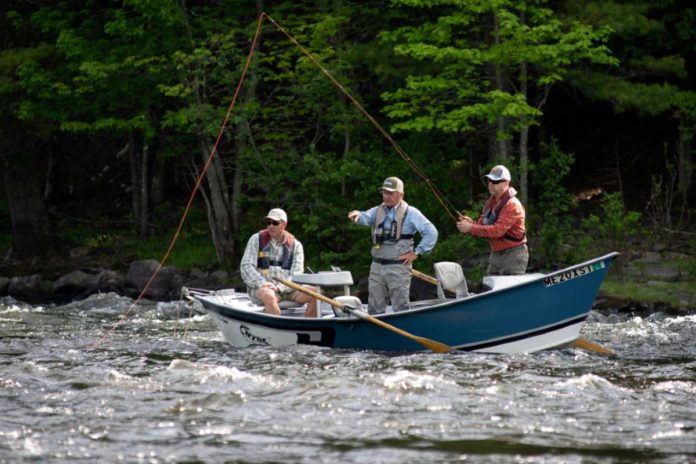Registered Maine Guides’ top priority is safely providing a fun and rewarding experience in their role as stewards of our natural resources.
That’s why news that freshwater fish in the state have tested positive for “forever chemicals” has generated unease as they confront a potential threat to their livelihood.
“Anything that’s such a detriment to the environment is always in the forefront of my mind, whether it’s mercury pollution or PFAS,” said guide Sean McCormick, who owns Blue Heron Fly Fishing based in Whitefield. “We just keep piling things on and on and on and on.”
Maine’s consideration of issuing more “do not eat” advisories for the state’s freshwater fish is another blow for anglers who have already had to modify their practices due to mercury pollution. In light of this new information, Maine guides believe the best way to stay safe is to encourage people not to eat freshwater fish.
Many guides already operate strictly on a catch-and-release basis.
“The fly fishing crowd, very seldom do they want to eat fish,” said Wayne Plummer, who since 2000 has operated Northern Pride Lodge in Kokadjo with his wife Barb.
The dangers of PFAS — short for per- and polyfluoroalkyl substances — to humans, fish, animals and birds resonate with guides who work on and around the Kennebec River, which for decades has been a repository for effluent from paper mills.
Even so, there is no sense of panic among guides, who are eager to find out what they’ll be dealing with as more information becomes available.
PFAS have been used in U.S. manufacturing since the 1950s and are found in a multitude of household products and packaging. They have been associated with health issues including elevated risk of kidney and testicular cancer and small decreases in infant birth weight.
Plummer, who guides anglers on the Kennebec and the Penobscot, said fishing is different on remote ponds, where campers and recreational anglers sometimes enjoy a meal.
“They get their four or five 10-, 11-inch brook trout and that’s their breakfast,” Plummer said.
Catch-and-release fishing not only keeps anglers out of harm’s way, it also protects the resource for all to enjoy.
“Live fish are worth way more to me as a guide than dead ones,” McCormick said. “Clients have many times caught the same fish, multiple days in a row — big fish — or even caught them two years in a row.”
That doesn’t mean there isn’t room for anglers to harvest fish. Some lakes and ponds are overpopulated with game fish, so eating a few, while adhering to the state’s consumption advisories, has been common.
For decades, fish in Maine have been known to contain mercury, a dangerous heavy metal that also is the byproduct of industrial processes. That hasn’t stopped anglers from fishing or eating freshwater fish in moderation.
Master Maine Guide Don Kleiner, operator of Maine Outdoors in Union, often guides people who are new to fishing, including families with young children. He worries PFAS contamination could scare people away from enjoying those outings.
“Every kid wants to take home a few perch filets that they caught to eat, and even the current warnings give me concern about letting them have that important part of their experience,” Kleiner said. “We will lose something important to not only being a kid, but the pathway to making more folks connected to the natural world and concerned about conservation in the future.”
Fishing groups, lake associations and chambers of commerce are already meeting to figure out how to maintain Maine’s image as a go-to fishing and outdoor recreation destination.
“I hope they figure it out much sooner than later, that’s for sure,” Hebert said.
Since many anglers come to Maine from other states and countries, guides are preparing to explain the known dynamics of PFAS in fish to prospective clients based on the information available.
“Certainly it is not a good thing, but at what levels are there impacts that should concern us?” asked Kleiner, who recently completed his tenure as the executive director of the Maine Professional Guides Association.
He is hopeful further study of PFAS and advances in testing will answer some of the questions.
“After the human health impact there needs to be an understanding of what the impacts are for our fish and wildlife,” Kleiner said. “The conservation impact is the one I worry about most because we can provide clean water for the human population, but fish and wildlife are another matter.”
The Kennebec flows along the eastern border of Fairfield, which in September 2020 became the focal point of PFAS in Maine. The Department of Environmental Protection found the so-called forever chemicals in well water, the result of waste sludge and septage being spread on local farm fields.
Last December, the Maine Department of Inland Fisheries and Wildlife issued a “do not eat” advisory for deer harvested in and around Fairfield after tissue samples revealed that some of the animals living near those farms revealed high levels of PFAS.
This spring, DIF&W also is testing wild turkeys in the vicinity to determine whether the chemicals are present in those game animals.
“PFAS is getting into fish, but what kind of other environmental issues will it cause?” wondered Registered Maine Guide T.J. Hebert, a longtime Kennebec River angler who operates Maineiac Outfitter in Clinton.
“Will it affect the birds that eat the fish, not just humans, but other predators?”
More articles from the BDN
Credit: Source link































